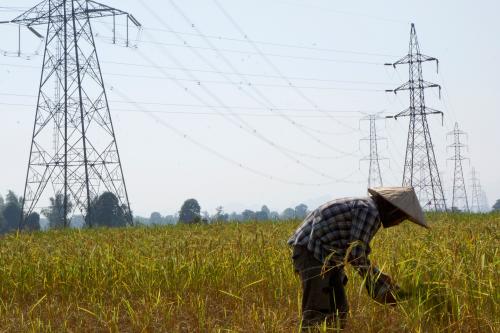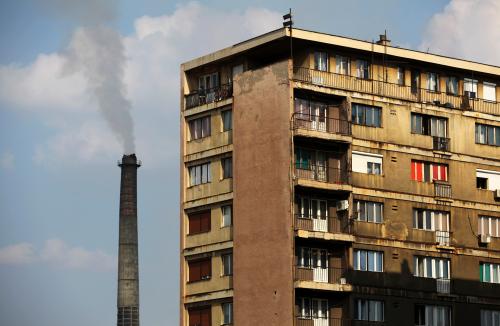Last week, the International Monetary Fund and the World Bank held their annual Spring Meetings, bringing together leaders across public and private financial sectors to discuss issues of global concern. Top of mind was financing sustainable development and the progress being made in integrating sustainability into global financial markets.
The United Nations Environment Programme Financial Inquiry launched a new report, “Making Waves: Aligning the Financial System with Sustainable Development.” The report reviews progress between 2014 and 2017. In 2014, there was a mix of skepticism and optimism. Today, there is momentum for more transformative integration.
“Surely you cannot touch the financial system: It’s sacred,” exclaimed one seasoned climate negotiator when hearing of the goals of the U.N. Environment Inquiry in 2014.
“Admirable, but a fool’s errand to suppose that global finance as a system can be aligned with sustainable development,” concluded some of our best friends.
“At last!” commented one institutional investor who shared a growing view that reforming the financial system was key to making substantial environmental and social progress.
Our mandate was to advance options for improving the financial system’s effectiveness in mobilizing capital toward a green and inclusive economy. Yet from the outset, there was simple disbelief that it was possible or appropriate to systematically insert sustainable development as a design criteria into the heartland of the $300 trillion global financial system.
Conventional wisdom, after all, has it that policies and financial rule making are better kept apart. Stated more bluntly—don’t mess with financial markets.
What the Inquiry found was that many parts of the world were not organized according to such convention. Particularly in developing countries from South Africa to Indonesia and Bangladesh, and from China to Peru, we found a “quiet revolution” in progress in shaping financial markets according to diverse policy priorities, from financial inclusion, to air pollution, to black economic empowerment, and to climate.
Two years into the Inquiry, on October 8, 2015, we launched its first global report, “The Financial System We Need: Aligning the Financial System with Sustainable Development,” to a packed hall at the International Monetary Fund and World Bank Annual Meetings in Lima, Peru. It was the first time that the U.N., let alone the U.N. agency responsible for environmental issues, had chaired a panel of central bank governors to talk not about the environment, but the future of the financial system. (A full list of reports is available here.)
When the curtain on the one-hour event came down, it was evident that we had crossed a threshold making it harder to exclude the matter of environment, climate and sustainable development from the business of financial policymakers and regulators. Reinforcing this was the announcement by China during the discussion not only that it would take green finance into the G-20 finance track during its presidency in 2016, but, in a historic step, that it was asking the U.N. Environment to manage this work stream on its behalf.
Today, less than two and a half years later, it would be hard for any central bank governor to dismiss the relevance to his or her work of sustainable development. Such a shift in so short a period is remarkable in itself, and has been achieved through the hard labor of many amazing people and initiatives. And although there is much to be done in translating this into tangible, ambitious action, we see a growing proportion of bankers, investors, stock exchanges, and insurance firms making commitments to align their operations with climate change and broader sustainable development objectives. Citizens and civil society organizations have also moved into the financial system arena, stimulating incumbents to look afresh at their purpose and practice.
The Inquiry has tracked the global number and range of policy measures to advance aspects of sustainable finance. At the end of 2013, 139 subnational, national-level, and international policy and regulatory measures were in place across 44 jurisdictions. Most of these were first-generation efforts to improve disclosure in securities markets and by pension funds. Four years on, the number of measures has not only doubled—to 300 in 54 jurisdictions—but the pattern of activity has changed fundamentally, with a substantial rise in system-level initiatives, which now account for a quarter of the total. These include the growth in national level roadmaps for green and sustainable finance in countries, including China, the EU, Italy, Indonesia, and Morocco, just to name a few.
Figure 1: The doubling in policy and regulatory measures, 2013-2017
Source: www.unepinquiry.org
Moving from momentum to transformation is unfinished business. For example, there has been a 14-fold increase in labeled green bond issuance from just $11 billion in 2013 to $155 billion in 2017. Yet such progress needs to be set against the scale of the global bond market of around $100 trillion. Similarly, there has been an increase in the divestments in carbon-intensive assets to an estimated $5 trillion in 2016, but we equally need to set this against investments in coal, oil, and gas over the same period of around $710 billion.
Progress to date should not discourage more transformative ambition to reshape finance, given the challenges we face and the opportunities that this finance could realize. There is certainly a need for more of both to get to where we need to be. While the job is clearly not done, many actors can and will take the agenda of sustainable finance forward, within national governments, civil society, international organizations, financial institutions, and across the U.N. system.
Aligning the financial system with the U.N. 2030 Agenda for Sustainable Development is not just a matter of more of the same, but of harnessing major change opportunities, given the complexity and dynamism of this system, rather than seeking to blueprint solutions as one might in designing, say, a car. For example:
- Financial crises offer major opportunities to reshape aspects of the financial system, as has the recent one, albeit with mixed results.
- International political agreements offer opportunities to shape systemic outcomes, such as the Paris Climate Agreement, which has helped system-level initiatives to advance climate considerations across the financial system.
- Digitalization will transform the financial system, and its relationship with the real economy, creating many new opportunities for advancing financing for sustainable development.
- Major investment programs such as China’s Belt and Road initiative, provide opportunities to influence the alignment of major investment flows.
The Inquiry’s approach, and for opportunities going forward, is to harness such transformational waves, rather than taking the well-worn approach of experimenting through pilots and then scaling through replication. The Inquiry, although having completed its 50-month journey, has spawned and supported the emergence of many ongoing, catalytic initiatives. This includes our work with the G-20 on sustainable finance, and several coalitions of the willing, including the Network of Financial Centres for Sustainability: The Sustainable Digital Finance Alliance, co-founded by U.N. Environment and Ant Financial Services, and the Sustainable Insurance Forum.
The Inquiry has been a catalyst for change, not an underlying driver. Its value-add, beyond being in the right place at the right time, was to uncover the many relevant innovative initiatives created by extraordinary champions from around the world, connect these initiatives directly through the exchange of experience across its partners, and on that basis to shape an overarching narrative that validated the ambition to align global finance with sustainable development.
Its approach proved to be quite powerful in encouraging systemic change. It is an open question as to whether there may be lessons from the Inquiry for catalyzing other aspects of sustainable development…but that is for another day.
Dr. Simon Zadek was a co-director of the U.N. Environment Inquiry into Design Options for a Sustainable Financial System (2014-2018); and is visiting professor and senior fellow at the Singapore Management University.
This post draws from the Inquiry’s fourth and final global report, “Making Waves: Aligning the Financial System with Sustainable Development.”







Commentary
Reforming the financial system to align with sustainable development
April 24, 2018